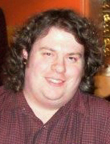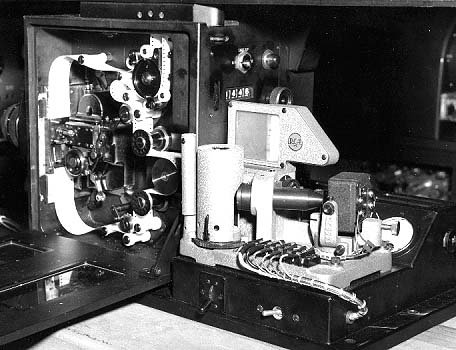|
|
This topic comprises 3 pages: 1 2 3
|
|
Author
|
Topic: Telecines
|
|
|
John Pytlak
Film God

Posts: 9987
From: Rochester, NY 14650-1922
Registered: Jan 2000
|
 posted 08-02-2004 05:30 AM
posted 08-02-2004 05:30 AM





Telecines used to be based on studio video camera technology, using vidicon or plumbicon tubes (e.g., RCA TK27).
Rank (Cintel) and Kodak pioneered the use of flying spot scanner technology for high-end telecines, which allowed continuous-motion gentle handling of film negatives. The Thomson Spirit DataCines use Kodak technology for their illumination and scanning system, using special line-array CCDs. Sony and Imagica have area array CCD telecines.
http://www.thomsongrassvalley.com/news/2003/20030912-sortzz-IBC_Spirt_4K.html
quote:
The new Grass Valley Spirit 4K high-performance film scanner specifically targets the rapidly growing digital intermediate market by improving scanning technology in a number of key areas. Its new dual-mode high-speed scanning capability offers RGB 2K scanning at up to 30 frames per second (fps) and 4K scanning—which is seen by many as the future of high-quality digital film post—at up to almost 8 fps. Both 16mm and 35mm film gauges and a wide variety of formats are supported. Support for 65mm, 70mm, and Super 8mm will be released in the near future...
As with the acclaimed Grass Valley Spirit DataCine, the optical and imaging subsystems have been developed with Thomson by Eastman Kodak. This provides diffuse illumination to minimize the effects of surface scratches and dust. Optical film matching and optical gain control are also included, and the lens gates include filter drawers for "in-camera" effects.
Image capture is by custom-designed, dual-array CCDs, offering native 2K and 4K resolution. The CCD output is converted to 16-bit digital signal processing for unmatched quality. Facilities include RGB color correction, with the ability to connect third-party secondary color processors into the internal signal path. The internal scaling engine provides a 4K-for-2K mode which benefits from 4K oversampling to eliminate aliasing and other artifacts. The data outputs use the Gigabyte System Network (GSN) interface which comfortably supports real-time 2K transfers.
| IP: Logged
|
|
|
|
Stephen Furley
Film God

Posts: 3059
From: Coulsdon, Croydon, England
Registered: May 2002
|
 posted 08-17-2004 06:52 AM
posted 08-17-2004 06:52 AM




In PAL-land, where there is no need for the 3:2 pulldown, intermittant projector style telecine equipment went out for broadcast use long ago. The only place I ever actually saw it was at the studios of the Innner London Education Authority, for whom I worked at the time. I had to visit their studios once. They had bought a lot of ex. broadcast black and white equipment when they set up their television service. They were also the only people I know who used the half speed option on 2" Quad tape, on Ampex VR2000 I think it was. I can't remember what cameras they were using.
Flying spot machines were the standard for many years; take a look at the Cintel section on this site: http://www.bbctv-ap.co.uk/bbctvp1.htm Scroll down to 'Contents', and then select item 3. Anybody who has seen the 'Elephant's foot' version of the Kalee 21 projector will recognise the top spool box on this thing. Also, the general styling is rather similar.
Michael, are you familiar with the Mechau projector? The BBC at one time used machines based on this for both telecine and film recording. There's a lot of interesting stuff on this site.
The original 1936 studios at Alexandra Palace still exist, the BBC finally moved out in the '80s, and most of that area is now derelict, and unsafe, though one of the studios is sometimes opened to visitors, it's tiny.
| IP: Logged
|
|
|
|
|
|
Steve Kraus
Film God

Posts: 4094
From: Chicago, IL, USA
Registered: May 2000
|
 posted 08-17-2004 10:02 PM
posted 08-17-2004 10:02 PM



The older style system for telecine like was used in tv stations airing film directly usually had several projectors beaming into the camera with selection made via a mirror multiplexer which had first-surface mirrors that could flip up or down quickly for on air changes between machines or slide to film etc. The camera didn't look anything like a regular camera, more like a large square cabinet with a hole in the side where the image beamed in. Internally it was just like a standard camera just not as crammed together. Lens. Color separating prism. Three camera tubes with deflection yokes.
The modern telecine systems are generally of two types: Flying spot scanners or CCD. From the outside they look similar, like this Rank which, IIRC is a flying spot canner.

A flying spot scanner contains a little monochrome CRT (picture tube). A raster is scanned on the tube. That is, a scanning pattern without any picture, just white. This is focused onto the film via an optical system. The flying spot refers to the spot of light the electron beam paints onto the CRT phosphor screen...it's only one tiny point at any given time...thus the film is being scanned with light. After the film it's no longer an image...just varying levels of light and an optical system relays this to a color disecting prism and photomultipliers or other light pickup.
By changing the size or shape of the raster on the CRT it is possible to zoom into the film, de-anamorphose Scope images, pan & scan etc. with no loss of resolution, at least not on the electronic side.
The other system uses CCD chips like you have in a camera except these are typically a single line with the second dimension coming from the motion of the film. Scan the film into a frame store memory as it rolls by then at the other end crank out the data in whatever arrangement you need (such as 2:1 interlaced normal video). Light source. Film. Optics. Prism. CCD chips for red, blue, green. Just like a camera except for the one dimension aspect.
Bosch once experimented with adding an extra CCD for infra-red. It would pick up little to no image on color film (the dyes being transparent to IR). Any spots seen would have to be dirt and therefore it would know to conceal it by replacing with an average of adjacent pixels. I don't know if it was ever marketed.
| IP: Logged
|
|
|
|
|
|
|
|
|
|
|
|
Steve Kraus
Film God

Posts: 4094
From: Chicago, IL, USA
Registered: May 2000
|
 posted 08-18-2004 01:19 PM
posted 08-18-2004 01:19 PM



You're talking about the old stuff; I'm talking about color footage that originated on tape and is preserved on film, presumably 16mm.
There was something in SMPTEJ once about a system, German I think, that kinescoped a live feed, reversal processed it, projected it, and washed off the emulsion and recoated it, all in a big endless loop.
Nice kinescope camera + sound recorder you show there. I wonder if that is a small sprocket after the lower loop but before the sound drum or just some sort of impedance roller. The sound part is probably standard Photophone with light source, mirror galvo over on the right and various optics.
| IP: Logged
|
|
|
|
Stephen Furley
Film God

Posts: 3059
From: Coulsdon, Croydon, England
Registered: May 2002
|
 posted 08-18-2004 03:44 PM
posted 08-18-2004 03:44 PM




In the '60s, the BBC still had some fairly ancient Cintel telecine equipment, though not as old as that on the site that I linked to. I also saw, disused in a museum, a machiine which had been converted to colour at some time during its life, with new solid state electronics replacing the original valves. don't know how common these conversions were. These machines must have also been converted to 625 lines, or been built as dual, or triple, or quad, standard, as they were certainly old enough to have been in use in 405 line days.
In 1974 (I think) visited the then newly opened studios of London Weekend television, on the South Bank in London. A lot of material was still being transmitted direct from film at that time. I don't know what make theiir equipment was, but they were vertical machines, bult into a 19" rack cabinet, or something of simlar size. They looked something like the studio versions of the Kinoton projectors. They had separate machines for 16mm and 35mm. On my next visit to the BBC, in the '80s, they were using Cintel Mk. 3 machines. They have an in-house built 9.5mm gate. By this time live transmission from telecine was on its way out. All of this equipment was flying spot.
Do television studios still have their own telecine departments, or is it all contracted out to facilities houses now?
As for film recordng, two early types of BBC equipment are shown on the site I linked to. The BBC were quite late getting iinto video tape, I think they bought their first Ampex Quad machines in 1962; most studio productions at that time went out live, and no recording was made of most of them. What recording there was was on film. Because the whole of Britain is in the same time zone, they didn't have the need to record for time-shifting purposes, as existed elsewhere. Before going for the Ampex machines thed did experiment with a system of their own, known as 'VERA'. It was a linear recording system wth large spools of tape.
In the '80s Rank had a laser reconding system for 16mm colour film. The results were quite good.
The BBC were making 16mm film recordings of their programmes for export purposes, for many years, but I don't know what technology was uses. Some of the 'lost' programmes have been restored from film copies whiich had been found in overseas vaults.
A couple of sites dealing with the Dr. Who restorations:
http://www.restoration-team.co.uk/
http://www.geocities.com/TelevisionCity/Lot/8256/landf.htm
| IP: Logged
|
|
|
|
All times are Central (GMT -6:00)
|
This topic comprises 3 pages: 1 2 3
|
Powered by Infopop Corporation
UBB.classicTM
6.3.1.2
The Film-Tech Forums are designed for various members related to the cinema industry to express their opinions, viewpoints and testimonials on various products, services and events based upon speculation, personal knowledge and factual information through use, therefore all views represented here allow no liability upon the publishers of this web site and the owners of said views assume no liability for any ill will resulting from these postings. The posts made here are for educational as well as entertainment purposes and as such anyone viewing this portion of the website must accept these views as statements of the author of that opinion
and agrees to release the authors from any and all liability.
|

 Home
Home
 Products
Products
 Store
Store
 Forum
Forum
 Warehouse
Warehouse
 Contact Us
Contact Us




 Printer-friendly view of this topic
Printer-friendly view of this topic



















